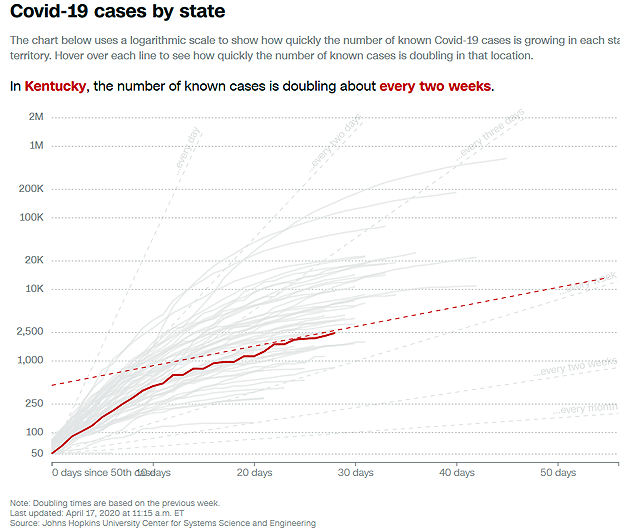Average age of Kentuckians killed by covid-19 is 52; protesters return to Capitol; testing shortage still major obstacle to reopening

CNN chart using Johns Hopkins data shows trend since 50th case was reported. Chart scale is logarithmic: rising numeric values occupy increasingly less vertical space. Note case numbers on left.
—–
As news develops about the coronavirus and its covid-19 disease, this item will be updated. Official state guidance is at kycovid19.ky.gov
“Protesters returned to the state Capitol late Friday morning and were met with barricades erected by Kentucky State Police,” the Lexington Herald-Leader reports. “They hung signs outside the windows of their pickup trucks, sedans and SUVs and circled the Capitol using car horns instead of megaphones to express their displeasure. By noon, around 15 cars circled the Capitol for the drive-by protest of Gov. Andy Beshear’s coronavirus related restrictions, urging the governor to allow businesses across the state to reopen.”
Beshear announced eight more covid-19 deaths, for a total of 137, and 134 new cases, for a corrected total of 2,522. For the first time, he announced the average age of Kentucky cases: 52. “Anyone and everybody can get the coronavirus,” he said, adding that the 11-day-old baby in Lincoln County who tested positive is “home, and from what I’m told, is doing OK.”
Five deaths were in long-term care facilities, for a total 43, including one staffer; the facilities now have 313 residents and 158 staff with positive test results.
Beshear reported the death of a 49-year-old inmate from Jefferson County at the Green River Correctional Complex in Central City. “We’re taking a number of steps at Green River,” he said, adding that the inmate was serving a nine-year sentence for assault and escape and had three years left to serve. He said 19 inmates and 15 employees in the corrections system have tested positive.
- President Trump is leaving it to states to “make the hard decisions about when and how to safely kick-start the country,” Politico reports. “The White House guidelines laid out Thursday envision a three-stage easing of social distancing restrictions, starting with the return of restaurants and gyms, and progressing to schools and eventually workplaces, but there are no target dates despite Trump’s previously stated May 1 goal, only vague criteria that states must be seeing a downward trajectory in cases and have access to robust testing. Beyond that, the president is making clear that it’s up to governors to make the most critical decisions.”
- The big obstacle remains lack of testing to track and understand the virus, and “We cannot do it without federal help,” New York Gov Andrew Cuomo said. Politico reports, “Commercial lab testing has slowed dramatically, and it remains unclear how testing across the nation will be ramped up — and what the plan is for reopening if health officials can’t see where and how fast the virus is spreading. . . . A White House coronavirus task force official said Thursday night that an increase in providers running point-of-care tests “far exceeds the drop in commercial lab testing.” Former FDA Commissioner Scott Gottlieb has suggested it may take 3.8 million tests per week for the nation to be able to head off new outbreaks.”
- Health officials say the nation will need more public-health workers to do contact tracing before stay-at-home orders are lifted, The Associated Press reports. Contact tracing involves tracking down contacts of people who have tested positive for the coronavirus, and getting them into quarantine or to call in daily with a health report. Experts say this will be necessary to suppress a resurgence of covid-19.
- “A groundbreaking study by Stanford [University] researchers released Friday indicated that far more Americans than previously indicated may have been infected . . . and now carry the protective antibodies, a sign of possible immunity,” The Washington Post reports. The study tested 3,300 volunteers in Santa Clara County, California, and found that 2.5 to 4.2% were positive for the covid-19 antibody.
- The Post reports on a long list of drugs that could treat covid-19, but warns to not expect a magic bullet: “Despite Trump’s boosterism, there are no treatments ready to fight covid-19.”
- 3D-printed swabs developed by the University of Louisville are in the works and could be ready by May, says a U of L Health Sciences Center news release. Swabs have been as hard or harder to come by than tests in some cases.
- Emergency-style palliative care must be implemented to meet the needs of covid-19 patients who wouldn’t benefit from a ventilator, says a Lancaster University news release. “Many patients are too unwell to benefit from ventilation but still need their symptoms managing,” said Professor Nancy Preston, co-director of the university’s International Observatory on End of Life Care.
- Health experts say breastfeeding is still recommended during the pandemic because it strengthens the immune system by directly transferring antibodies from the mother, notes a University of Pennsylvania School of Nursing news release.